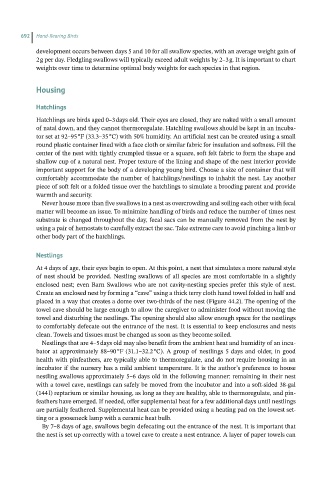Page 691 - Hand rearing birds second
P. 691
692 Hand-Rearing Birds
development occurs between days 5 and 10 for all swallow species, with an average weight gain of
2 g per day. Fledgling swallows will typically exceed adult weights by 2–3 g. It is important to chart
weights over time to determine optimal body weights for each species in that region.
Housing
Hatchlings
Hatchlings are birds aged 0–3 days old. Their eyes are closed, they are naked with a small amount
of natal down, and they cannot thermoregulate. Hatchling swallows should be kept in an incuba-
tor set at 92–95 °F (33.3–35 °C) with 50% humidity. An artificial nest can be created using a small
round plastic container lined with a face cloth or similar fabric for insulation and softness. Fill the
center of the nest with tightly crumpled tissue or a square, soft felt fabric to form the shape and
shallow cup of a natural nest. Proper texture of the lining and shape of the nest interior provide
important support for the body of a developing young bird. Choose a size of container that will
comfortably accommodate the number of hatchlings/nestlings to inhabit the nest. Lay another
piece of soft felt or a folded tissue over the hatchlings to simulate a brooding parent and provide
warmth and security.
Never house more than five swallows in a nest as overcrowding and soiling each other with fecal
matter will become an issue. To minimize handling of birds and reduce the number of times nest
substrate is changed throughout the day, fecal sacs can be manually removed from the nest by
using a pair of hemostats to carefully extract the sac. Take extreme care to avoid pinching a limb or
other body part of the hatchlings.
Nestlings
At 4 days of age, their eyes begin to open. At this point, a nest that simulates a more natural style
of nest should be provided. Nestling swallows of all species are most comfortable in a slightly
enclosed nest; even Barn Swallows who are not cavity‐nesting species prefer this style of nest.
Create an enclosed nest by forming a “cave” using a thick terry cloth hand towel folded in half and
placed in a way that creates a dome over two‐thirds of the nest (Figure 44.2). The opening of the
towel cave should be large enough to allow the caregiver to administer food without moving the
towel and disturbing the nestlings. The opening should also allow enough space for the nestlings
to comfortably defecate out the entrance of the nest. It is essential to keep enclosures and nests
clean. Towels and tissues must be changed as soon as they become soiled.
Nestlings that are 4–5 days old may also benefit from the ambient heat and humidity of an incu-
bator at approximately 88–90 °F (31.1–32.2 °C). A group of nestlings 5 days and older, in good
health with pinfeathers, are typically able to thermoregulate, and do not require housing in an
incubator if the nursery has a mild ambient temperature. It is the author’s preference to house
nestling swallows approximately 5–6 days old in the following manner: remaining in their nest
with a towel cave, nestlings can safely be moved from the incubator and into a soft‐sided 38‐gal
(144 l) reptarium or similar housing, as long as they are healthy, able to thermoregulate, and pin-
feathers have emerged. If needed, offer supplemental heat for a few additional days until nestlings
are partially feathered. Supplemental heat can be provided using a heating pad on the lowest set-
ting or a gooseneck lamp with a ceramic heat bulb.
By 7–8 days of age, swallows begin defecating out the entrance of the nest. It is important that
the nest is set up correctly with a towel cave to create a nest entrance. A layer of paper towels can

